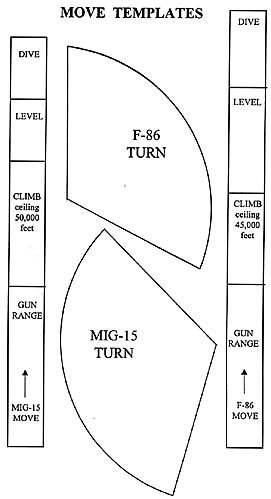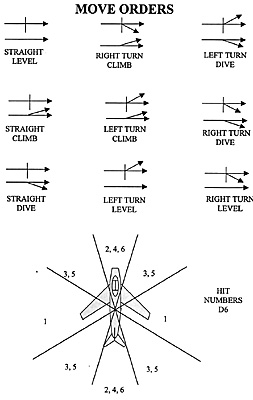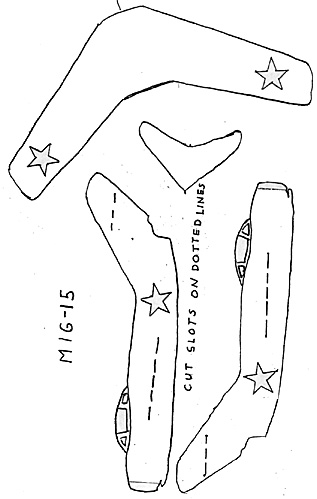The Basic Game
This is a very fast playing game. A one-on-one dogfight can be played in less than fifteen minutes. Nearly all the information a player needs is on the movement templates. Shooting is simple. All you need is one die (D-6) and the diagram of hit numbers for various angles. I have used this basic system for a variety of situations. Once I did a multi-player game of World War I dogfighting. There were about five players on each side and the planes were 1/72 scale. The game was a smashing success. There was a mid-air collision between planes on the Allied side. The game started as a World War II dogfight over North Africa, but quickly moved to China and became Flying Tigers versus Zeroes. These were mostly 1/300th scale. Later I did Mig-15 versus F-86 Sabre over Korea as a one-on-one game in 1/72 scale. In preparing this game I looked at my templates etc. from that earlier effort and revised a bit.
Once you understand the basic game its pretty simple to do a solo version. The postal version is even easier. For purposes of rules explanation I will use 1/300 scale, the scale I use for nearly all my games. Later we can look at other scales.
For sake of an example, lets assume the Mig-15 and F-86 Sabre start facing each other two moves apart at 20,000 feet altitude. Each player puts his plane in position balanced on top of four lego blocks facing the other. The planes should be about fourteen inches apart, more or less. Each player then writes his first move order. They should each have a sheet of paper. If a player wants to fly straight ahead his move order will look like The top symbol indicates the plane is not turning. The lower symbol indicates level flight. Writing the order takes seconds. If the player had wanted to turn he would indicate meaning left turn or meaning right turn. For a climb the lower symbol is and for a dive its A diving right turn looks like this . See the illustration for all the possibilities. Once orders are written moves are simultaneous.
Each player takes the proper movement template and moves his plane. Each player should carefully notice if his plane ever is in a position to shoot the other plane at any time in the move. If a plane is flying straight ahead, the player places the straight flight template beside his plane. Usually I put the end of the template at the point on the plane where the wing joins the fuselage. Then the player simply slides the plane on its legos so the wing root is at the place on the template marked "level". If the player is turning his plane, he places the turning template with the start point on the wing root and the plane's heading perpendicular to the radius of the turn curve. Then he slides the lego base around the curve until the wing root is at the other end of the curve and tangent to the curve.
If a plane is diving or climbing, its move should be along the straight template to the line marked "climb" or "dive." A climbing or diving turn is moved on the turn template. The turn template does not have different stop points for these. At the end of a climb or dive the player should adjust his plane's height by adding one lego for a climb or removing one lego for a dive.
Be aware that each plane has a ceiling (Mig-15, 50,000 feet; F-86, 45,000 feet), and a dive from 5000 feet has a sudden stop at the end. Some mountains are 6,000 feet tall. One special problem is collision. If two planes fly a collision course, movement is frozen at mid move and each player writes orders for the second half of the move. If the planes are still on a collision course, each player dices to see if the pilot ejects. Roll one die; 4 or 6 means pilot ejects. The actual process of moving takes a few seconds, then its on to shooting.
Both planes shoot straight ahead. The movement template for straight ahead has a shooting range marked on it. If at any time in the move the enemy plane passed in front of your plane in range, you get a shot. Use the diagram giving hit numbers. Roll one regular die (D-6). If the Mig-15 hits the Sabre, its over. The Sabre has to hit the Mig-15 twice to shoot it down. You will notice that the best shot is either at the enemy's tail or his front. Deflection shots one a passing target are harder. Note hits on your paper that you are using to write orders.
Moves --- the numbers/inches
| 1/300 | level flight | diving | climbing | turn radius | turn degrees | gun range |
|---|---|---|---|---|---|---|
| F-86 | 6 11/16" | 8 3/16" | 4 11/16" | 2 7/8" | 120 degrees | 3" |
| Mig-15 | 6 9/16" | 7 11/16" | 5 1/4" | 3" | 120 degrees | 3" |
| 1/72 F-86 | 26 3/4" | 32 3/4" | 18 3/4" | 11 1/2" | 120 degrees | 12" |
| 1/72 Mig-15 | 26 1/4" | 30 3/4" | 21" | 12" | 120 degrees | 12" |
Representing Altitude
In this game a plane gains or loses altitude in 5000 foot steps. A plane at 20,000 feet loses 5000 feet in a dive and moves forward the length of a dive move on its movement template. Planes can only shoot others planes at the same altitude, so keeping track of altitude is very important. Also this is what makes this an air game. Ships and soldiers move in two dimensions - submarines and paratroops excepted. Planes move in three dimensions. This also raises the problem of representing height in a wargame table. I have never seen a completely satisfactory system, but here are some options. The scale of the model planes often is important in deciding which system works best.
Written altitude. Put a clip of paper or cardboard next to the model with its altitude written on it. This lacks visual appeal, but its easy. Notice I use it in the postal game.
Lego blocks. I have used this system with 1/300 scale solid models and 1/150 cardboard models. It gives a clear quick reading on altitude. One block equals 5000 feet. It moves well. The lego blocks slide along movement templates nicely without displacing the model. The brightly colored blocks do sort of wipe out any illusion of flight. This is still my first choice.
Glasses. Clear glasses turned bottom up make stable platforms for 1/300 planes and being transparent they give an illusion of flight. Precise movement is a problem. I have only used them when planes were doing close air support. In that case the precise location is not as critical as in a dogfight. My grandson, Peter, and I were fighting in North Africa about 1942. The Allied side got two P-40 Kittyhawks. Peter asked Grandma for two glasses so the planes could fly over the battlefield. She got them quickly. I wonder how quickly I could get them for a dog fight. Also our glasses don't come in enough different heights.
Folded supports. Cardboard or better yet clear plastic folded to a V or L when standing on edge is pretty good. It can be shaped to fit a 1/72 scale model or smaller. A clear plastic stand disappears once placed on a game table. It is a little tippy, and models have to be balanced just so but the planes look as if they are flying. The only source of clear plastic V shapes I have used is the dividers in cookie packages. Plain old cereal box cardboard can be used but lacks the visual appeal. You need to have lots of different heights. That could be a lot of clutter.
Sticks and clamps. For 1/72 scale models some versions of a stick standing on the floor with the plane fastened to it is very practical. A dowel with a wood block base and a fastener of some kind is fairly handy. Fletcher Pratt used a flange from the hardware store and recommended that plane movement be measured from the base of the rod. This was good advice in the 1940s and still looks good to me. The telescoping aerial from a car combined with an alligator clip from the hardware store would be very elegant and excellent for paper models. There is no end to the mechanical variations on this idea
String is good. Donald Featherstone describes a variety of nets, harnesses etc. for supporting planes in his book. The string nets work great for 1/72 scale models flying over battle fields. There is a problem with altitude and precise movement like dogfighting.
Models
In most of my games I use 1/300 scale models. There are commercial suppliers but I cast my own planes using a rather antique method. For purposes of this article I have prepared some paper or cardstock models. These give a fair likeness of the planes. I used similar models to play this version of the game. Usually paper models have to be about 1/150 to be large enough to be practical. I can't cut wing slits in 1/300 scale paper models. If you get really serious about models you can buy 1/72 scale plastic models. Both planes are available in that scale.
Due to the way Lone Warrior is produced, I have no idea what scale the paper planes in this article are. I have drawn the movement template in 1/300 scale and the plane models in 1/72 scale. If you have access to a photo copier that enlarges or shrinks you can enlarge the images in Lone Warrior back to 1/72 scale. The drawings should be colored and then glued to cardboard. Glue the wing and tail drawing to the top side. Glue one side of the fuselage drawing to the cardboard, then cut out the profile and glue the other fuselage drawing to the reverse side. A good stiff cardboard is best. Breakfast cereal boxes are pretty good. In fact in World War II some breakfast cereals came with models printed on them. My favorite cardboard is from the backs of paper tablets. Both air forces left their planes in natural aluminum mostly. The star on the Mig-15 was red and the front had a red band on it. The Sabre also was silver. The U.S. Air Force insignia featured a white star against a blue circle. The bars on either side were white framed with blue and had a narrow red line in the middle. The Sabre also had broad yellow stripes on the fuselage, rudder and wings. I have omitted serial numbers and other smaller markings.
Assembly of the Mig-15 model is simple. Cut slots in the fuselage and tail along the dotted lines. A small dab of glue will help hold things in place. For the Sabre, cut along the dotted line in the tail and the wing. Insert the tail. Insert the tabs sticking down from the fuselage through the wing. Put glue on the tabs and fold the tabs up against the wing.




More Korea MiG Alley
Related
- WWII Flying Tigers
MiG Pilot Korean War Solo Game [LW # 145]
Back to Table of Contents -- Lone Warrior #127
Back to Lone Warrior List of Issues
Back to MagWeb Magazine List
© Copyright 1999 by Solo Wargamers Association.
This article appears in MagWeb (Magazine Web) on the Internet World Wide Web.
Other military history articles and gaming articles are available at http://www.magweb.com
